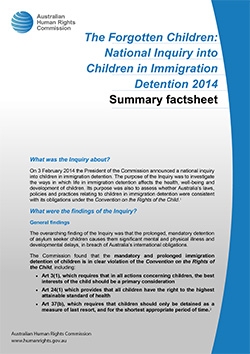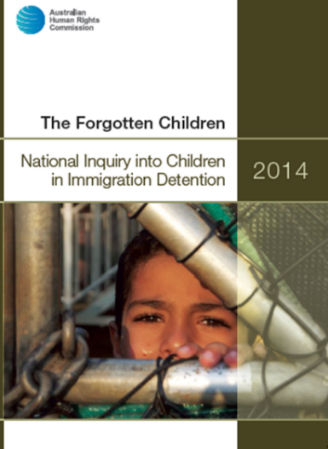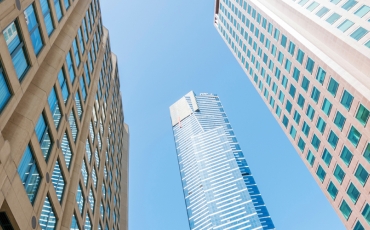Summary factsheet - The Forgotten Children: National Inquiry into Children in Immigration Detention 2014

The Forgotten Children: National Inquiry into Children in Immigration Detention 2014
Summary factsheet
July 2015
What was the Inquiry about?
On 3 February 2014 the President of the Commission announced a national inquiry into children in immigration detention. The purpose of the Inquiry was to investigate the ways in which life in immigration detention affects the health, well-being and development of children. Its purpose was also to assess whether Australia’s laws, policies and practices relating to children in immigration detention were consistent with its obligations under the Convention on the Rights of the Child.[1]
What were the findings of the Inquiry?
General findings
The overarching finding of the Inquiry was that the prolonged, mandatory detention of asylum seeker children causes them significant mental and physical illness and developmental delays, in breach of Australia’s international obligations.
The Commission found that the mandatory and prolonged immigration detention of children is in clear violation of the Convention on the Rights of the Child, including:
- Art 3(1), which requires that in all actions concerning children, the best interests of the child should be a primary consideration
- Art 24(1) which provides that all children have the right to the highest attainable standard of health
- Art 37(b), which requires that children should only be detained as a measure of last resort, and for the shortest appropriate period of time.[2]
Factual findings
The Commission made the following factual findings:
- Prolonged detention is having profoundly negative impacts on the mental and emotional health and development of children. In the first half of 2014, 34 percent of children in detention were assessed as having mental health disorders at levels of seriousness that were comparable with children receiving outpatient mental health services in Australia. Less than two percent of children in the Australian population were receiving outpatient mental health services in 2014.[3]
- The numerous reported incidents of assaults, sexual assaults and self-harm involving children indicate the danger of the detention environment.[4] In a 15 month period, from January 2013 to March 2014, 128 children in detention engaged in acts of self-harm, including attempted suicide.[5]
The children were aged 12 to 17 year old. From January 2013 to March 2014 the following incidents were reporting as occurring in detention centres where children were held:
- 207 incidents of actual self-harm
- 210 incidents of voluntary starvation (27 of which included children )
- 436 incidents of threatened self-harm
- 57 serious assaults
- 233 assaults involving children
- 33 incidents of reported sexual assault (the vast majority involving children).[6]
- The deprivation of liberty and the exposure to high numbers of mentally unwell adults are causing emotional and developmental disorders amongst children in immigration detention. Children are detained in close confinement with adults who suffer high levels of mental illness. Thirty percent of adults detained with children have moderate to severe mental illnesses.[7]
- The harsh and cramped living conditions on Christmas Island created particular physical illnesses amongst children.[8]
- Some children have been detained for longer than 27 months because at least one of their parents has an adverse security assessment by ASIO.[9]
Specific legal findings
The Commission made specific legal findings that:
- The failure of the Commonwealth to provide education to school aged children on Christmas Island between July 2013 and July 2014 is a breach of the right to education in article 28(1) of the Convention on the Rights of the Child.[10]
- The failure of the Commonwealth to remove unaccompanied children from detention environments which inhibit recovery from past trauma is a breach of article 39 of the Convention on the Rights of the Child.[11]
- The failure of the Minister for Immigration and Border Protection to release unaccompanied children from detention breaches the Convention on the Rights of the Child, articles 3(1) and 18(1).[12]
- Current guardianship arrangements do not afford unaccompanied children special protection and assistance, in breach of article 20(1) and (2) of the Convention on the Rights of the Child.[13]
- The failure of the Commonwealth to appoint an independent guardian for unaccompanied children in immigration detention breaches the Convention on the Rights of the Child, article 20(1).[14]
- The decision of the Commonwealth to approve the use of force to transfer unaccompanied children from Charlie Compound to Bravo Compound on 24 March 2014 breaches article 37(c) of the Convention on the Rights of the Child.[15]
Findings and concerns in relation to children detained in Nauru[16]
In August 2012 Australia re-introduced a system of third country processing for asylum seekers who come by boat, including children. Under this system, asylum seekers who arrive without a valid visa must be transferred to a ‘regional processing centre’ in a third country (currently Nauru or Papua New Guinea) as soon as is reasonably practicable, unless the Minister for Immigration decides otherwise. At the time of the Inquiry there were no children detained in the centre in PNG.
The Inquiry team could not travel to Nauru, but accepted evidence from people with first-hand experience of the situation in the centre on the island. The Inquiry team received written submissions from children and adults detained in the centre in Nauru, and evidence from doctors, teachers and child welfare workers who had worked in the centre.[17]
The Commission made the following findings regarding Australia’s transfer of child asylum seekers to Nauru:
- Children on Nauru are suffering from extreme levels of physical, emotional, psychological and developmental distress
- the inevitable and foreseeable consequence of Australia’s transfer of children to Nauru is that they would be detained in breach of article 37(b) of the Convention on the Rights of the Child
- Australia transferred children to Nauru regardless of whether this was in their best interests, in breach of article 3(1) of the Convention on the Rights of the Child.[18]
In addition the Commission raised serious concerns that the conditions in which children are detained on Nauru are in breach of the Convention on the Rights of the Child, articles 16(1), 19(1), 20(1), 24(1), 27(1), 27(3), 28, 31, 34 and 37(a).[19]
What were the recommendations of the Inquiry?
On the basis of these findings, the Commission recommended that:
- All children and their families be released from immigration detention in Australia and Nauru into community detention or the community on bridging visas with a right to work (Rec 1).
- The Migration Act 1958 (Cth) be amended to ensure that children may be detained for only so long as is necessary for health, identity and security checks. Continued detention beyond this period of time should only be permitted following an individual and periodic assessment by a court or tribunal of the necessity for this continued detention (Rec 2).
- Assessment of refugee status be commenced within four weeks of the tabling of the report (Rec 3).
- No child or parent be sent offshore for processing unless it is clear that their human rights will be respected (Rec 4).
- All immigration detention facilities on Christmas Island be closed (Rec 5).
- An independent guardian be appointed for unaccompanied children seeking asylum in Australia (Rec 6).
- An independent review be conducted into the decision to approve the use of force to transfer unaccompanied children on Christmas Island on 24 March 2014 (Rec 7).
- All detention centres be equipped with sufficient CCTV or other cameras to capture significant incidents in detention, and all recordings of such incidents should be maintained (Rec 8).
- ASIO review the case of each parent with an adverse security assessment in order to identify whether their family can be moved into the community, and alternative community detention be available for children of families assessed as security risks (Rec 9).
- Children in immigration detention be assessed regularly using the HoNOSCA mental health assessment tool (Rec 10).
- Children currently or previously detained at any time since 1992 have access to government funded mental health support (Rec 11).
- Children in detention who were denied education on Christmas Island for a year be assessed to determine what educational support they require (Rec 12).
- Children and families in immigration detention be given information about organisations that provide free legal advice and access to phones and computers (Rec 13).
- Legislation be enacted to give direct effect to the Convention on the Rights of the Child under Australian law (Rec 14).
- A royal commission be set up to examine the continued use since 1992 of the policy of mandatory detention and to consider remedies for any breaches of the rights of children that have been detained (Rec 15).
- An independent review of the implementation of these recommendations be conducted in 12 months (Rec 16).
What have been the positive developments since the Inquiry?
Since the announcement of the Inquiry on 3 February 2014, the Minister for Immigration and Border Protection has used his personal discretion under the Migration Act 1958 (Cth) to release hundreds of children and their family members from immigration detention facilities. As at 31 January 2014, there were 1,006 children in detention in Australia, and 132 in detention in Nauru.[20] As at 31 May 2015, there were 138 children in detention in Australia, and 81 detained in Nauru.[21]
The Government has also removed all children from the Christmas Island detention centres, and in the 2015-2016 Budget announced it will close the Phosphate Hill and Construction Camp detention centres on the island.[22]
Why are there children in immigration detention?
Australia is the only country in the world to detain asylum-seeking children as a first option. Under the Migration Act 1958 (Cth), non-citizen children who arrive without a visa must be detained, and are only released at the discretion of the Minister for Immigration and Border Protection. The policy and practice of detaining asylum-seeking children has been adopted by successive Australian Governments from both sides of politics for over 20 years.
How did the Inquiry team investigate the impacts of detention?
Through visits to 11 different detention centres, the Commission conducted interviews with 1,129 children and parents in immigration detention in Australia, using a standardized questionnaire. The Commission also conducted 104 interviews with people in the community who had formerly been detained.
A crucial aspect of the Inquiry was the involvement of internationally recognised medical experts as consultants who accompanied Inquiry staff on each of the detention centre visits, and submitted expert reports of their observations.[23]
The Commission received 239 submissions including from medical service providers, non-government organisations, professionals who had worked with children in immigration detention and children in detention on Nauru.[24]
The Commission conducted 5 public hearings at which 41 witnesses gave evidence under oath. These witnesses included doctors who had worked in immigration detention centres, the former Minister for Immigration the Hon Chris Bowen MP and the (then) Minister for Immigration the Hon Scott Morrison MP.[25]
The Commission also obtained and analysed information from the Department of Immigration and its contractors using the Commission’s powers to compel documents and information.
The final report of the Inquiry, The Forgotten Children: National Inquiry into Children in Immigration Detention 2014, was provided to the Attorney-General on 11 November 2014. The Attorney tabled the report in Federal Parliament on 11 February 2015. The full report is available in Word, PDF and HTML versions on the Commission’s website:https://www.humanrights.gov.au/our-work/asylum-seekers-and-refugees/publications/forgotten-children-national-inquiry-children
Notes
- [1] Convention on the Rights of the Child, 1989. At http://www.austlii.edu.au/au/other/dfat/treaties/1991/4.html (viewed 8 July 2015).
- [2] Australian Human Rights Commission, The Forgotten Children: National Inquiry into Children in Immigration Detention 2014 (2015), (The Forgotten Children) p 29 and pp 74-75. At https://www.humanrights.gov.au/our-work/asylum-seekers-and-refugees/publications/forgotten-children-national-inquiry-children (viewed 22 June 2015).
- [3] Australian Human Rights Commission, The Forgotten Children, p 29 and p 75.
- [4] Australian Human Rights Commission, The Forgotten Children, p 30 and p 76.
- [5] Australian Human Rights Commission, The Forgotten Children, p 62.
- [6] Australian Human Rights Commission, The Forgotten Children, above.
- [7] Australian Human Rights Commission, The Forgotten Children, p 30 and p 76.
- [8] Australian Human Rights Commission, The Forgotten Children, p 31 and p 76.
- [9] Australian Human Rights Commission, The Forgotten Children, p 35 and p 179.
- [10] Australian Human Rights Commission, The Forgotten Children, p 31 and pp 76-77.
- [11] Australian Human Rights Commission, The Forgotten Children, p 34 and p 170.
- [12] Australian Human Rights Commission, The Forgotten Children, pp 34-35 and p 170.
- [13] Australian Human Rights Commission, The Forgotten Children, p 35 and p 170.
- [14] Australian Human Rights Commission, The Forgotten Children, p 35 and p 170-171.
- [15] Australian Human Rights Commission, The Forgotten Children, p 35 and p 171. For details of this incident and breach, see pp 160-165.
- [16] See also the Commission’s factsheet Tell Me About: Children in immigration detention in Nauru (2015). At https://www.humanrights.gov.au/our-work/asylum-seekers-and-refugees/publications/tell-me-about-children-immigration-detention-nauru (viewed 22 June 2015).
- [17] All of the public submissions are available to read on the Commission’s website at http://www.humanrights.gov.au/our-work/asylum-seekers-and-refugees/national-inquiry-children-immigration-detention-2014-0 (viewed 8 July 2015).
- [18] Australian Human Rights Commission, The Forgotten Children, p 36 and p 195.
- [19] Australian Human Rights Commission, The Forgotten Children, above.
- [20] Department of Immigration and Border Protection, Immigration Detention and Community Statistics Summary: 31 January 2014 (February 2015), p 3. At http://www.border.gov.au/Busi/Comp/Immigration-detention (viewed 8 July 2015).
- [21] Department of Immigration and Border Protection, Immigration Detention and Community Statistics Summary: 31 May 2015 (June 2015), p 3. At http://www.border.gov.au/Busi/Comp/Immigration-detention (viewed 8 July 2015).
- [22] Australian Government, Budget 2015-16; Budget Measures, Budget Paper No.2 2015-16 (2015), p 119. At http://www.budget.gov.au/2015-16/content/bp2/html/index.htm (viewed 22 June 2015).
- [23] Six of these reports have been made publically available on the Commission’s website at http://www.humanrights.gov.au/our-work/asylum-seekers-and-refugees/national-inquiry-children-immigration-detention-2014/expert (viewed 5 May 2015).
- [24] All public submission have been published and are available to read here: https://www.humanrights.gov.au/our-work/asylum-seekers-and-refugees/national-inquiry-children-immigration-detention-2014-0 (viewed 19 June 2015).
- [25] Transcripts and videos of the evidence given at these hearings are available at https://www.humanrights.gov.au/our-work/asylum-seekers-and-refugees/national-inquiry-children-immigration-detention-2014-1 (viewed 19 June 2015).



